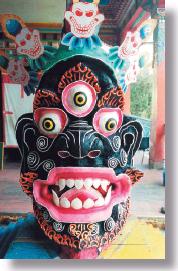The Origination of Mahakala
The Origination of Mahakala
When Guru Rinpoche Padmasambhava was in Tibet, he commanded Yeshe Tshogyal to conceal a terma (hidden treasure teaching) called Padma Thangyig Sertreng (The Golden Rosary of the Lotus-Born). This was later recovered by terton Urgyen Lingpa about 500 years later. In it is mentioned the origination of Mahakala.
Numerous aeons ago, a highly realised being called Tharpa Nagpo (Black Salvation) misinterpreted his Guru's teaching and began to live in dissolute and self indulgent lifestyle for which after his death he was reborn as animals and hungry ghosts for many lives and then fell into Vajra hell for countless ages.
At the age of Buddha Dipankara he was reborn as a hideous monster with 3 heads, 6 arms, 4 legs and 2 wings. At his birth, malignant epidemics, famine, bloodshed and other calamities struck he world. When his mother died nine days after his birth, he was deserted in a cemetery with his mother's corpse to die. By suckling on his dead mother's milk and eating the remains of the body, he survived and through scavenging in the cemetery, he grew into a terrible monster bearing fangs, wearing human skin, tiger skirt, elephant blouse and snakes belts, holding blood filled skull cup and waving a trident hunting human for food and terrorising everything in every destructive ways possible. As time went by he became very powerful, breathing poisonous air which caused epidemics to occur, and his ears, nose and body oozed out the 404 kinds of diseased. Thus he was called Matram Rudra, the incarnation of greatest evil, pride of egoism in its most terrible form. He then proceeded to conquer all the realms of Rakshasas, Nagas, Yakshas, Asuras, Ghandharvas and Devas, who make him their king, and they revelled in obscene orgies, killing, hunting and eating human beings.
At that time, out of great compassion Vajrasattva and Vajrapani manifested themselves into Hayagriva and Vajravarahi, the wrathful forms of Avalokiteshvara and Green Tara. Together they confronted the monstrous Matram Rudra. After some fierce battles which shook the whole universe, both Matram Rudra and his consort Krodeshvari were subdued. Having conquered Rudra, henceforth all the wrathful deities of Vajrayana assumed the eight accessories of Matram Rudra including the ferocious looks, sepulchral ornaments, and the glorious costumes.
After suffering terrible pain in defeat, Matram Rudra repented greatly and promised to protect all Dharma practitioners. Thus Hayagriva and Vajrapani pierced his heart with the kilaya, absolving him of all this karmic debts and flaws. They further gave him empowerments and transformed him into the great dharma protector, conferring him the secret name of Mahakala
Matram Rudra's transformation from greatest of all evil into the Dharma Protector Mahakala through the subjugation by Hayagriwa and Vajravarahi is none other than the triumph of compassion and skillful means over extreme evil, egoism and its transformation into wisdom. In the ultimate view, there is no separation between the AwakenedMind of Buddha and that of Mahakala.
Mahakala retains the wrathful forms and all the physical attributes of Matram Rudra. However, each attribute manifested is a skillful method to transform one's defilement into wisdom. Thus, Mahakala is in fact a wrathful embodiment of compassion.
As explained by Ven. Khenph Karthar Rinpoch in his article "Relating to the Mahakala Practice: "Appearing in very majestic form, splendid yet frightening, Mahakala stands in the midst of a mountain of flames to symbolize that no enemy can stand this appearance aspect; the sharp chopper, which he holds aloft in one hand, symbolizes the cutting through of negative patterns, aggression, hatred, ignorance - any of the five poisons. No neurosis or negativity can tolerate this very majestic form, the frightening form symbolizes Mahakala as totally devoid of feat or hesitation in his spontaneous yet consistent work toward the benefit and liberation of all beings.
Mahakala is seen standing on the corpse of two human bodies, thus symbolizing the death of negativities and the complete uprooting of negative patterns to such a point that, like a dead body they will not come to life. It is very important that we know these symbols of Mahakala because many times we have mistaken notions that he may be a clinging spirit of harmful, evil being, perhaps even the Lord of Death ready to devour and attack. One would find great difficulty in relating to the various symbols without understanding that our awakened compassion is the essential quality of the being of Mahakala. Mahakala has never been known to harm on being, even in the slightest manner, because he is constantly benefiting beings through the continuous play of the enlightened mind."
